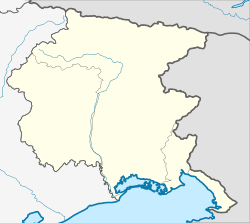This article needs additional citations for verification. (October 2019) |
Gorizia
| |
|---|---|
| Comune di Gorizia Občina Gorica Comun di Gurize | |
 The old part of Gorizia seen from the castle in August 2008 | |
| Coordinates: 45°56′N 13°37′E / 45.933°N 13.617°E | |
| Country | Italy |
| Region | Friuli-Venezia Giulia |
| Province | Gorizia |
| Frazioni | Castello, Lucinico (Ločnik), Oslavia (Oslavje), Piuma (Pevma), San Mauro (Šmaver), Sant'Andrea (Štandrež), Straccis (Stražišče), Vallone dell'Acqua, Gradiscutta, Piedimonte (Podgora) |
| Government | |
| • Mayor | Rodolfo Ziberna (Forza Italia) |
| Area | |
| • Total | 41 km2 (16 sq mi) |
| Elevation | 86 m (282 ft) |
| Population (November, 2022)[2] | |
| • Total | 33,584 |
| • Density | 820/km2 (2,100/sq mi) |
| Demonym(s) | Goriziani (Italian) Goričani (Slovene) |
| Time zone | UTC+1 (CET) |
| • Summer (DST) | UTC+2 (CEST) |
| Postal code | 34170 |
| Dialing code | 0481 |
| ISTAT code | 031007 |
| Patron saint | Saints Hilary and Tatian |
| Saint day | March 16 |
| Website | Official website |
Gorizia (Italian pronunciation: [ɡoˈrittsja] ; Slovene: Gorica [ɡɔˈɾìːtsa]), colloquially stara Gorica 'old Gorizia'[3][4] to distinguish it from Nova Gorica (Standard Friulian: Gurize, Southeastern Friulian: Guriza; Bisiacco: Gorisia; German: Görz [ɡœʁts] ), is a town and comune (municipality) in northeastern Italy, in the autonomous region of Friuli-Venezia Giulia. It is located at the foot of the Julian Alps, bordering Slovenia. It is the capital of the Regional decentralization entity of Gorizia and is a local center of tourism, industry, and commerce. Since 1947, a twin town of Nova Gorica has developed on the other side of the modern-day Italy–Slovenia border. The region was subject to territorial dispute between Italy and Yugoslavia after World War II: after the new boundaries were established in 1947 and the old town was left to Italy, Nova Gorica was built on the Yugoslav side. The two towns constitute a conurbation, which also includes the Slovenian municipality of Šempeter-Vrtojba. Since May 2011, these three towns have been joined in a common trans-border metropolitan zone, administered by a joint administration board.[5]
The name of the town comes from the Slovene word gorica 'little mountain', which is a common toponym in Slovene-inhabited areas.[6]
- ^ "Superficie di Comuni Province e Regioni italiane al 9 ottobre 2011". Italian National Institute of Statistics. Retrieved March 16, 2019.
- ^ "Popolazione Residente al 1° Gennaio 2018". Italian National Institute of Statistics. Retrieved March 16, 2019.
- ^ Meinhof, Ulrike Hanna (2002). Living (with) Borders: Identity Discourses on East-West Borders in Europe. Aldershot: Ashgate. p. 50.
- ^ Fidermuc, Katarina (May 14, 2017). "Za železnico lahko hkrati stojiš v dveh Goricah". Delo (in Slovenian). Retrieved December 27, 2017.
- ^ di Francesco Fain (May 12, 2011). "Patto Gorizia-Nova Gorica c-e la firma – Cronaca" (in Italian). Il Piccolo. Archived from the original on March 10, 2012. Retrieved August 25, 2012.
- ^ Snoj, Marko (2009). Etimološki slovar slovenskih zemljepisnih imen. Ljubljana: Modrijan. p. 144.




